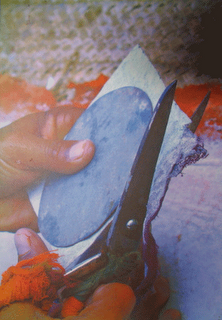 Ganjifa – a local note Rudolf von Leyden who did seminal work on Indian ganjifa wrote in the “The Naksha Game of Bishnupur and its implications” (The Journal of the Playing Card Society, Vol vi, no 3, February 1978) that he could not accept ‘ the Indian origin of these cards for the following reasons: 1 mode of manufacture : The cards are printed on cardboard in black from wood blocks and probably stencil coloured...This kind of manufacture of cards is entirely unknown in India and would point with a large degree of certainty to Europe’ The naqsha cards are not printed on cardboard or stencilled. They are
Ganjifa – a local note Rudolf von Leyden who did seminal work on Indian ganjifa wrote in the “The Naksha Game of Bishnupur and its implications” (The Journal of the Playing Card Society, Vol vi, no 3, February 1978) that he could not accept ‘ the Indian origin of these cards for the following reasons: 1 mode of manufacture : The cards are printed on cardboard in black from wood blocks and probably stencil coloured...This kind of manufacture of cards is entirely unknown in India and would point with a large degree of certainty to Europe’ The naqsha cards are not printed on cardboard or stencilled. They are made from boiling tamarind seeds and then mixed with cotton fibre and then coated with a clay that is local to Bishnupur to make the base and then they are hand painted. In fact the process appears to at least go back to mediaeval times. Alberuni ( AD 973 – 1043) ( Sachau, Volume 1, p 171) : Alberuni describes a slender tree like the date and coconut palms (which are distinct from the corypha and Borassus palms), “bearing edible fruits, and leaves of the length of one yard, and as broad as three fingers, one put beside the other”. Experts like Hoernle conclude that an error in transmission was responsible for the edible fruit as they were no such palms in existence at that time. The answer may be
simpler than expected. The error may be attributed to the etymology of tamarind called ‘date of the east’ in Arabic and the assumption that we are talking of some kind of palm tree, when in fact the process of making the base in Bishnupur looks closer to Alberuni’s description of paper in India, and accounts for the edible fruit.





No comments:
Post a Comment